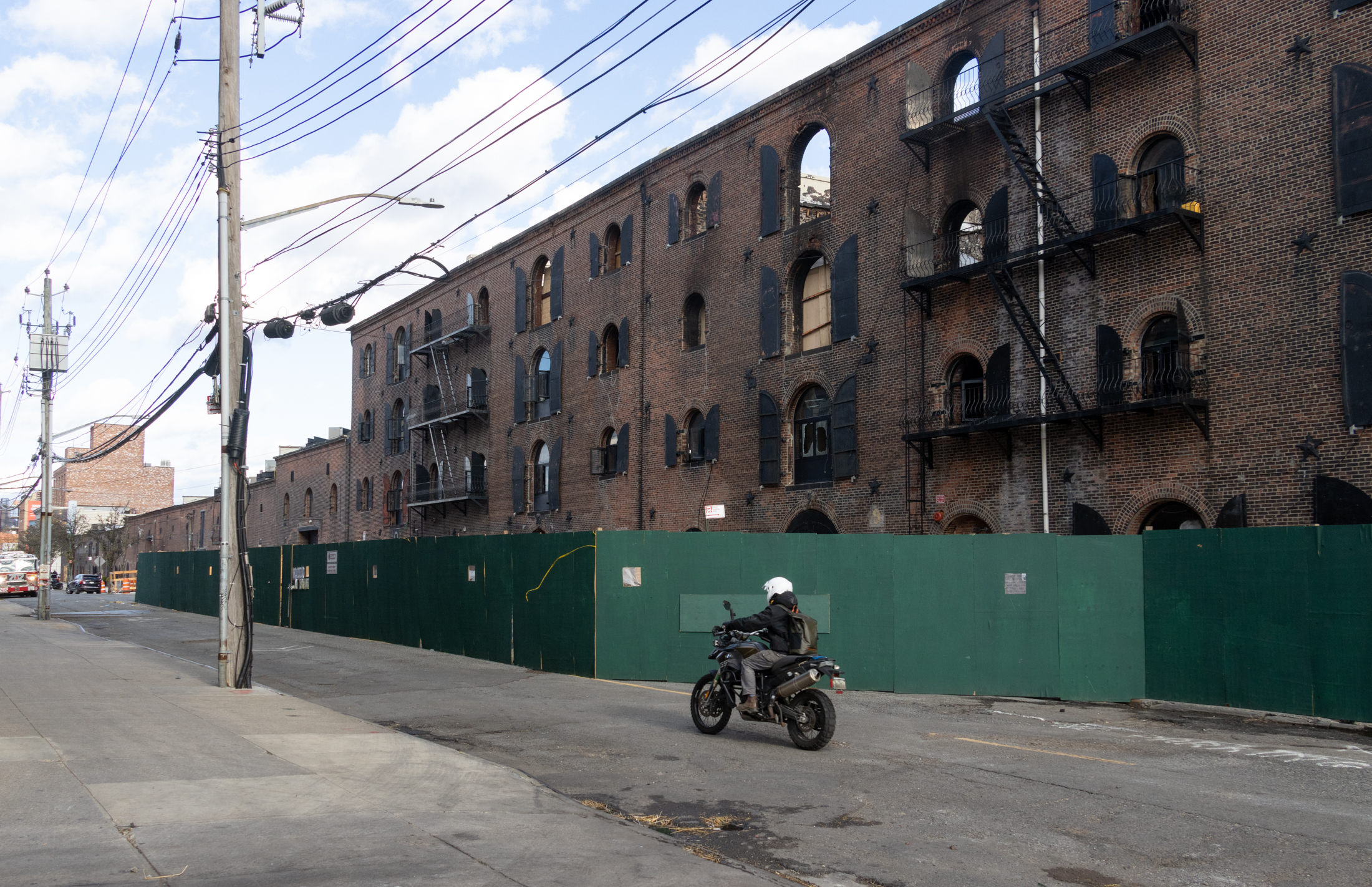Admiral's Row: "Extremely High Level of Historic Integrity"
A tipster who must have a day job as a stenographer passed along some highlights from the “Assessment of Admiral’s Row” report that was prepared by Beardsley Design Associates and Crawford & Stearns for the National Guard and was made briefly available for public viewing on Tuesday night. One of the main aspects that the…


A tipster who must have a day job as a stenographer passed along some highlights from the “Assessment of Admiral’s Row” report that was prepared by Beardsley Design Associates and Crawford & Stearns for the National Guard and was made briefly available for public viewing on Tuesday night. One of the main aspects that the consultants were charged with evaluating was the “historic integrity” of the site as a whole and the buildings individually. Bottom line: If the results were a report card, Admiral’s Row would have Straight A’s.
After application of the aspects of historic integrity to the collective Admiral’s Row district with due consideration of existing deterioration, it is apparent that all seven aspects of historic integrity are strongly present. The Admiral’s Row district retains an extremely high level of historic integrity to the historical significance of the BNY…After application of the aspects of historic integrity to the individual buildings, with due consideration of existing deterioration, it is apparent that all seven spects of historic integrity are strongly present in nine of the ten Quarters.
The report goes on to say that Quarters B and D are “exceptional and retain an extremely high level of historic integrity” while H, K, L and I retain a “high level” of historic integrity. Only Quarter C doesn’t make the grade with the consultants. And what kind of shape are the buildings in structurally? “In general, the structural integrity for the original 19th Century portions of the buildings’ superstructure appear to be sound, level and plumb.”
p.s. Readers may be interested in checking out Gowanus Lounge’s take on the situation this morning.
Officers’ Row: Let’s Have Our Cake and Eat It Too [Brownstoner]
Officers’ Row Preservation Coming to a Contentious Head [Brownstoner]
For Officer’s Row, Supermarket All But Certain [Brownstoner]
Admiral’s Row Fixup to Cost $20M [NY Daily News]
Real Estate Round-Up [Brooklyn Eagle]
Photo from Officersrow.org





This is just another tragic example of the failure of federal agencies and major American cities to embrace healthy redevelopment. These buildings should be saved (in deference to the cost, they could be renovated rather than restored), the supermarket built, the Navy Yard invested in still further, public transportation expanded. It would reinvigorate the local economy, create jobs, and give people hope about their urban enviroment. Instead the bureaucrats consistently fail the people.
1) Coordinated public statements by three public officials does not automatically equal corruption. THey all agree about what should be done, so they coordinated their message. That’s just the smart thing to do.
2)11:54 – WHere did you get your information that Thomas U Walter designed houses on Admirals Row? I am curious about the source. I have done alot of research on these houses and have never come across that. I would be very interested to know where that comes from and if it is in fact a believable source. Every record I have seen indicates that it was a staff architect for the Navy.
3)Also 11:54 – I am referring to a bunch of letters that went back and forth between the City and Army Corps subsequent to the signing on the MOU.
4) ALso – I don’t understand your point about the $30 million (or $25) going to AIDS research. I agree with you – that money could go towards any number of important causes – so what? Why does that disprove my point? My point is that government resources are scarce and that people have to realize that advocating for the government to pay for something means that they will have less money to pay for something else, or they will have to raise taxes. So these proposals need to be subjected to a strict cost-benefit analysis. Is it really worth it to spend this much money on these houses? Or does it make more sense to get a bigger bang for you buck and spend the money on restoring more important buildings in the yard that are not in nearly as bad shape, like the Hospital or the Surgeon’s house. Or how about spending the money to help grow Steiner Studios in a way that will allow them to house even more than the 1,000 jobs they already provide (keep in mind that most of those jobs are for middle -class blue collar electricians and carptenters, not Brad Pitt)? I think it’s an easy call.
5)11:47 – the problem with your argument is that the ideas that have been put forth are not in fact “good ideas” they are very bad ideas that are masquerading as good ideas but will in fact lead to a complete waste of time and money and not put us any closer to doing anything (either preservation or development) with this important property for many years to come.
Ella
“The unwillingness to be forthright about what’s really going on here fosters more than the usual cynical conspiracy theories.” Huh?
The Navy Yard has said, ‘we’re going to build a supermarket in response to the long standing (20 years) community request for one and we’re going to tear down the Admirals Row houses to do so because the cost of restoring them is not justified by the rents that will be generated.’ Someone can have a philosophical disagreement with that statement, but I fail to see what is not forthright about it.
Ella:
I urge you to update the estimated cost via yesterday’s Brownstoner comment. For your convenience – here it its:
“The Army Corps of Engineers study that was available for review last night (though not for distribution) put the cost of restoring the ten buildings at about $25 million, significantly less than what the BNYDC has been telling people; what’s more, according to one of the engineers manning the tables, eight of the ten houses are still structurally sound. Additionally, even a back-of-the-envelope sketch like the one above from Pratt’s Brent Porter shows that there may be much more creative solutions that let the community have its cake and eat it too.”
As for the corrupt officials – it’s hard to look past the three nearly identical talking points from our distinguished leaders. [See said Brownstoner post]. Also – Marty’s contribution to the Atlantic Yard debacle lingers.
Someone is coordinating this. We have a right to be suspicious.
Ella,
One and possibly three of the Admiral’s Row houses were designed by Thomas U. Walter as well. Mr. Walter designed the B Quarter was the home of Matthew Perry when he was in charge of the Navy Yard, before he “opened” Japan.
I don’t know where you are getting your information from – the MOU signed by the City & the SHPO from 1996 stipulated that the buildings were going to be demolished, and that HABS documentation was to be done (which it was in 2004 as part of the City ULURP process). Exactly which Federal agency owned the buildings at the time is an intersting question if one is so inclined to investigate. There was a lot of buck-passing among the feds about who was responsible for the properties.
I am not accusing anyone in political agencies of corruption or anything. What I think shoudl happen is an open and real discussion of these houses – based on the responsibilities of the government.
Oh, and the argument about $30 million (fake number by the way) going towards affordable housing and what-not? Can we retire that red herring? It could also by $30 million going towards AIDS research, preventing global warming, or giving every family in the Ingersoll Houses free wifi and the computers to utilize it.
Anon 10:28
Kudos to Gowanus Lounge, which said what I’ve been saying much better than I. Kudos also to Brownstoner, for keeping the Row on the front burner.
The unwillingness to be forthright about what’s really going on here fosters more than the usual cynical conspiracy theories. Good ideas for preserving at least the best of the Row AND having room for development have been put forth by both professionals and interested and concerned citizens. They are all dismissed out of hand. Yet when pressed as to why, all we get is that we don’t know what we are talking about, or we are asked by self proclaimed apologists to find funding for them. That is not the citizen’s job or responsibility to do so, unless hired by the Yard or someone in authority.
They clamor that the need to raze the Row for a supermarket and parking lot is so great that attempts to restore even part of the Row cannot be entertained. Yet when alternatives are suggested, they say that no developers or any money people have been signed on to build said market, so there is no money. So what’s the rush to tear down for? As I said yesterday – please! And there is a nearby bridge for sale, too.
Why should any potential “saviours” step up, if they aren’t even going to be seriously considered? Why should anyone spend their time and money putting together a plan or proposal if the audition is rigged, and the bulldozers are going to take the show, no matter what?
The complications of ownership and use because of federal gov’t claims, military use and subsequent secrecy and lack of public accessibility, historical provenance, the City of New York’s involvement, a private company’s interests – the Navy Yard, and concerned citizens who mostly want to see the at least the best of the Row preserved in some way, shape, or form, AND the need for income producing development, make this a very complicated stewpot that is being very privately guarded. This in not how our nation’s and city’s history should be handled.
Ella,
way to go.
eloquent and correct.
whoever wrote that the building proposed for the museum is not historic doesn’t know the first thing about the Navy Yard.
Thank you.
1) No backroom deals have been made. Navy Yard officials have committed themselves to an open RFP process to ensure that everything is on the up and up. Just because you don’t understand all of the facts and constraints they are working under, doesn’t mean that these people are corrupt. I think we should save our collective outrage for corrupt government officials for those occasions when it’s actually happening. If we accuse everyone of corruption, then it starts to lose meaning.
2) The Navy Yard has never really argued that the houses were not historically significant or that, with enough money, they couldn’t be restored. The argument has always been (and continues to be) that the amount of money it would take to do so isn’t worth it considering that there is only a finite amount of government subsidy to go around. Spending the $30 million to fix up these houses is $30 million that can’t go towards affordable housing, or education, or transit. It’s a judgement call, and the people whpo are charged with making it have decided it’s not worth it. If you disagree, then you have to answer to those people who would have benefitted from the other programs that would have to get funded in order to do this
3)The other argument has always been – what are you going to do with them once they are restored – and is that worth it? Is it really worth $30 million to wind up with boutiques and fancy bakeries across the street from one of the most economically disadvantaged housing projects in the City? Will those residents benefit from that? I don’t think so.
4)To the commenter who said that the Navy Yard historical center is a less historical building – on what basis do you make that claim? Do you know anything about the history of these buildings? In reality the Navy Yard historical center building is a SIGNFICANTLY more historic building. It used to be the marine commandants house and is the last building left from a small Marines base that existed on the site. The entire Marines campus was designed by THomas U. Walter, who is one of the deans of American Architecture. He was the 4th architect of the capitol and actually designed significant portions of the capitol building, the library of congress, and many historical buildings in Philadelphia. According to some architectural historians I’ve spoken with, this is probably the only remaining building of his in New York. The admirals row houses were designed by a staff architect for the Navy. Now you have some facts, now tell me which building is more historically significant.
5) Here’s another history lesson. During the late 90’s when the City was speaking to the Feds about acquiring the houses, they said that they would only acquire the buildings if the Feds first fixed them up or provided the funds to do so. THe feds said they would have to find the funding to do that and the NOTHING HAPPENED for 8 years until the City said that they would acquire the buildings without the Feds being required to fix them up, but only if that requirement didn’t fall on the City. Does the City/Navy Yard’s position make more sense now?
-Ella
The houses look like they are partially collapsed because the wooden porches and sunrooms have rotted and collapsed. But the main houses themselves, made of brick and stone, are structuraly sound. But they need a full, soup-to-nuts restoration. That would be relatively straightforward but very expensive as anyone who has restored a decrepit brownstone knows. Unfortunately I think these houses have a lot of admirers but no saviors. No one has stepped up and said I will restore them for my company or organization and we will lease them or buy them. Everyone wants somebody else to do it, but that entity has not materialized.